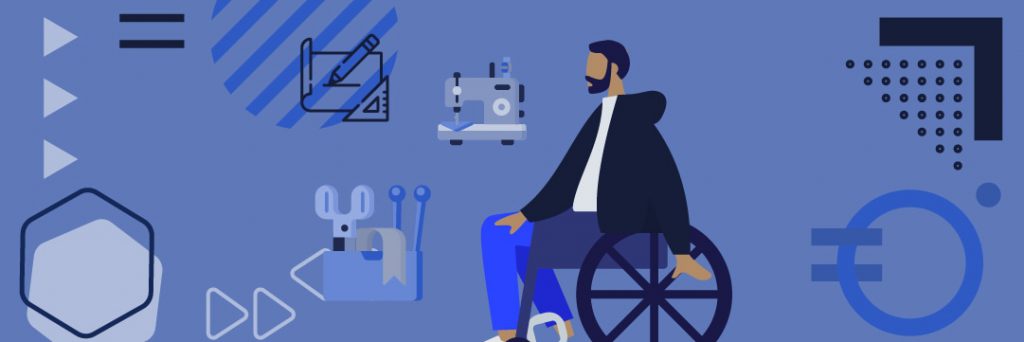Costumes – they captivate and enthrall us by setting the stage and creating a visual aesthetic in movies, plays, and TV. If you have always dreamed of having your hand in this but would like just a little bit more info, read on to learn about how to become a costume designer.
What is Costume Design
If you are thinking about how to become a costume designer, you probably have some knowledge of what a designer does. But let’s start from the very beginning and talk about what exactly costume design is besides beautiful clothes that represent an entire story. And just a side note, to be effective, the clothes aren’t always beautiful, sometimes they’re kind of grungy and ugly, but that’s all part of the story, too.
Backstage.com tells us that:
A costume designer plans and creates the clothing and accessories worn by the characters in a film, series, or theater production.
According to legendary costume designer Edith Head, costume designers “create the illusion of changing actors into what they are not. We ask the public to believe that every time they see a performer on the screen, he’s [or she’s] become a different person.”
In other words, the audience should be able to identify a character and what they stand for and who they are by what they wear. It’s the visual identity. Remember, costumes come in all shapes and forms. From the intricate costumes of period pieces to the regular clothes of current dramas, costume design covers everything a character wears.
In our day to day life, we identify people by their clothes. We all are familiar with mom clothes (whatever that means), and when you see a person in scrubs, you figure they do something in the medical field. We can often identify people and their region by their clothes; there’s the chill vibe of California style and the warm coziness of Northeastern sweaters and hats. The more detailed a costume becomes, the more it speaks of the character.
Clothing elements
Think beyond the main outfits and reflect on those specific elements that make a character. Masterclass reminds us of Superman’s cape and Dorothy’s slippers. These are iconic elements that are a classic giveaway of a character. And the costume designer came up with them. So maybe you aren’t interested in designing costumes from top to bottom but want to work with a specific element of design, like hats or shoes.
Costume design versus fashion design
Many of us tend to think of fashion designers when we think of costumes, but there are some definite differences. For one, the costumes usually have certain specifics to follow – whether in conjunction with a definitive time period or with an element of fantasy. These professionals also usually work with a team while those in the fashion industry work alone and in a less fantasy and fictional sense. The target audience is also very different. Much of their skillset is similar, though.
Some Absolutely Fabulous Examples of Costume Design
In an article about costume design, we have to talk about costumes! Right now, The Queen’s Gambit and Bridgerton are wowing us with their stand out costumes. From the stylish clothes of the 1950’s and 1960’s that also incorporate Beth’s love of chess through numerous checkered patterns, The Queen’s Gambit takes us on a visual journey of gorgeous, symbolic style. Bridgerton is another Netflix show wooing us with style.
Here’s how the costume designer of Bridgerton works. Ellen Mirojnick says she tackled this project the way she always does with historical work: first by looking at the period she’s working in, then amplifying it. The result is a funkier, louder, wilder version of the 1800s.
We should mention some other productions with fabulous fashion…
- Black Panther, 2018
- Fantastic Beasts and Where to Find Them, 2016
- The Great Gatsby, 2013
- Alice In Wonderland, 2010
Our list can go on and on.. but we need to move on…
How to Become a Costume Designer
Now that we know what costume design is, and we are drooling over costumes, let’s see how you go about becoming a costume designer.

Skillset
There are certain skills that you need if you are interested in becoming a costume designer. For one, you need that passion for design and an artistic nature. You’ll have to able to work well with others and see their vision. After all, you are the one that brings it to life. Most professions where are you creating involve working with others to create their vision, from motion graphic artists to video editors.
Research skills are important components of a costume designer’s skill set. They need to be able to research a time period or social group and learn what’s important in costume. They also should know how to portray even more than that with costume, like Beth’s checkerboard coats in The Queen’s Gambit. So, a good grasp of symbolism and color representation is important.
Another important skill that designers are honing in on now is the skill of digital creation. A lot of costume design is done digitally with different software and art programs. The more versatile you can be, the better your chance of landing jobs in this field.
Other skills are a strong knowledge of all different time periods, fabrics, fashion, architecture, and literature. Yes, you do need to be pretty well versed. And along with working well with others, you should have a trustworthy, dependable, and organized nature. Remember, you need to meet your deadlines and be an assertive, well-spoken creative. Whew, we know that’s a lot!
Script Reading
Of course, when you are working on creating costumes, you have to be familiar with the script. This is the same for an elementary school play as it is for a million-dollar production. So when you begin, before anything else, read the script and read it well. Envision the characters and think about how to represent them, the time period, and the physical setting.
Getting started with jobs
As far as jobs go, most costume designers start at entry-level or as an assistant. Don’t be afraid to take this on. You’ll have the opportunity to move up quickly. Also, take on freelance jobs. It’s a great way to get started, think school plays or community theater productions. You’ll have fun, be able to be creative, and get in the field all at the same time. Masterclass tells us this about freelance work in this field:
Though some costume designers are employed by specific theatre companies or production houses, most work freelance on a variety of different productions. Part of the excitement and draw of costume design, is the opportunity to create a diverse array of costumes and explore unique narratives and characters with each new project.
This is one field where experience and a good portfolio really do count. So every job, big or small, is a step in the right direction. Even small, local jobs provide experience and material for that portfolio.
Onto the Costumes
Once you’ve landed a job and done your research, it’s time to create the costumes. Not every piece has to be an original design. You may spend some time scouring second-hand shops and eBay for specific pieces. You’ll be working with the other players in the production, from actors to directors to makeup artists. Your costumes will accentuate and amplify the message of the production. Think about your actors as you design. An eight-year-old in a school play will need a very different costume than a 20-something. It’s time to put it all together and design away!
Promoting Yourself
As you become more confident in your work, you’ll be more prepared to take on more jobs. Promotion is key, especially as a freelancer. Think about how you’d like to work. Maybe it would help if you were on with a company to help you find work. Many freelancers work with companies like Bunny Studio who take the hard work out of finding jobs.
Look local. As we mentioned, you probably have a lot of opportunities within your community. School systems often have plays going on, and there are usually some theater groups around that you could promote yourself to. The more you work, the more jobs you’ll get. Here’s some great advice from our own Bunny Studio on self-promotion in the world of freelance art, illustration, and design:
If you want to get jobs on a consistent basis, then you’ll need to display as much of your work online as possible. You need to provide easy, accessible ways to elegantly display your artwork and the jobs you’re most proud of. You won’t believe how many would-be clients are scouring DeviantArt for talented freelancers.
Your Portfolio
Speaking of displaying your work, you definitely want to invest in creating a show-stopping portfolio. Here is where you’ll put your best work together, like photos from the beginning of your process to the end of production. That means your preliminary sketches to the actors wearing your designs in the productions themselves. Include mood boards and research notes. Of course, this can be a digital portfolio, and there are plenty of sites out there to work on. Just make sure it’s something you’re proud to share and that it showcases your best work.
Summing Up How to Become a Costume Designer
As with any profession, you’ve got to have the right skills, the right demeanor, and the right drive to be a costume designer. But if you want, it’s yours for the taking. People are in awe of great costumes, and from that small school play full of 8-year-olds to a multi-million dollar production, the costumes themselves are essentially characters. So if you’ve got the drive, the artistic skills, the love of research, and the door open to getting work in the costume design field, you’re on the right path! The Queen’s Gambit or Star Wars wouldn’t be the same without their fabulous costumes. And where would Dorothy be without those ruby slippers? If you think your design skills may be a fit for us at Bunny Studio, please reach out. We’d love to chat!










